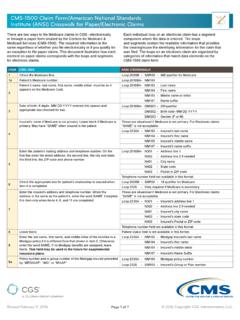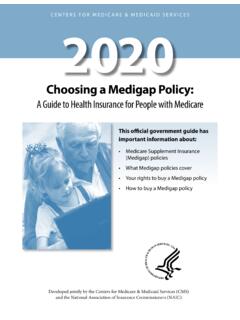Transcription of 2020 Instructions for Form 8889 - IRS tax forms
1 Userid: CPMS chema: instrxLeadpct: 100%Pt. size: Draft Ok to PrintAH XSL/XMLF ileid: .. ions/I8889/2019/A/XML/Cycle01/source(Ini t. & Date) _____Page 1 of 7 11:07 - 4-Jun-2019 The type and rule above prints on all proofs including departmental reproduction proofs. MUST be removed before for form 8889 Health Savings Accounts (HSAs)Department of the TreasuryInternal Revenue ServiceSection references are to the Internal Revenue Code unless otherwise DevelopmentsFor the latest information about developments related to form 8889 and its Instructions , such as legislation enacted after they were published, go to InstructionsPurpose of FormUse form 8889 to: Report health savings account (HSA) contributions (including those made on your behalf and employer contributions), Figure your HSA deduction, Report distributions from HSAs, and Figure amounts you must include in income and additional tax you may owe if you fail to be an eligible information.
2 See Pub. 969, Health Savings Accounts and Other Tax-Favored Health Plans, for more details on HSAs. Also, see Instructions for form 1040 or 1040-SR and Instructions for form Must FileYou must file form 8889 if any of the following applies. You (or someone on your behalf, including your employer) made contributions for 2019 to your HSA. You received HSA distributions in 2019. You must include certain amounts in income because you failed to be an eligible individual during the testing period. You acquired an interest in an HSA because of the death of the account beneficiary. See Death of Account Beneficiary, you (or your spouse, if filing jointly) received HSA distributions in 2019, you must file form 8889 with form 1040, form 1040-SR, or form 1040-NR, even if you have no taxable income or any other reason for filing form 1040, form 1040-SR, or form !
3 DefinitionsEligible IndividualTo be eligible to have contributions made to your HSA, you must be covered under a high deductible health plan (HDHP) and have no other health coverage except permitted coverage. If you are an eligible individual, anyone can contribute to your HSA. However, you cannot be enrolled in Medicare or be another person's dependent. An individual does not fail to be treated as an eligible individual for any period merely because the individual receives hospital care or medical services under any law administered by the Secretary of Veterans Affairs for a service-connected disability. You must be, or be considered, an eligible individual on the first day of a month to take an HSA deduction for that month (see Last-month rule next).Last-month rule. If you are an eligible individual on the first day of the last month of your tax year (December 1 for most taxpayers), you are considered to be an eligible individual for the entire period.
4 You must remain an eligible individual during the testing period. The testing period begins with the last month of your tax year and ends on the last day of the 12th month following that month (for example, December 1, 2019 December 31, 2020). If you fail to remain an eligible individual during this period, other than because of death or becoming disabled, you will have to include in income the total contributions made that would not have been made except for the last-month rule. You include this amount in income in the year in which you fail to be an eligible individual. This amount is also subject to a 10% additional tax. (See Part III.)Account BeneficiaryThe account beneficiary is the individual on whose behalf the HSA was , an HSA is a health savings account set up exclusively for paying the qualified medical expenses of the account beneficiary or the account beneficiary's spouse or From an HSAD istributions from an HSA used exclusively to pay qualified medical expenses of the account beneficiary, spouse, or dependents are excludable from gross income.
5 (See the Line 15 Instructions for information on medical expenses of dependents not claimed on your return.) You can receive distributions from an HSA even if you are not currently eligible to have contributions made to the HSA. However, any part of a distribution not used to pay qualified medical expenses is includible in gross income and is subject to an additional 20% tax unless an exception Medical ExpensesGenerally, qualified medical expenses for HSA purposes are unreimbursed medical expenses that could otherwise be deducted on Schedule A ( form 1040 or 1040-SR). See the Instructions for Schedule A and Pub. 502, Medical and Dental Expenses. Expenses incurred before you establish your HSA are not qualified medical expenses. If, under the last-month rule, you are considered to be an eligible individual for the entire year for determining the contribution amount, only those expenses incurred after you actually establish your HSA are qualified medical Only prescribed medicines or drugs (including over-the-counter medicines and drugs that are prescribed) and insulin (even if purchased without a prescription) for the account beneficiary, the account beneficiary's spouse or dependent(s), are qualified medical cannot treat insurance premiums as qualified medical expenses unless the premiums are care (LTC) insurance,Jun 04, 2019 Cat.
6 No. 37971 YPage 2 of 7 Fileid: .. ions/I8889/2019/A/XML/Cycle01/source11:0 7 - 4-Jun-2019 The type and rule above prints on all proofs including departmental reproduction proofs. MUST be removed before care continuation coverage (such as coverage under COBRA), care coverage while receiving unemployment compensation under federal or state law, and other health care coverage if you were 65 or older (other than premiums for a Medicare supplemental policy , such as medigap ).Coverage under (2) and (3) can be for your spouse or a dependent meeting the requirement. For (4), if you, the account beneficiary, are under age 65, Medicare premiums for your spouse or dependents (who are age 65 or older) generally are not qualified medical Deductible Health PlanAn HDHP is a health plan that meets the following coverageFamily coverageMinimum annual deductible$1,350$2,700 Maximum annual out-of-pocket expenses* $6,750$13,500* This limit does not apply to deductibles and expenses for out-of-network services if the plan uses a network of providers.
7 Instead, only deductibles and out-of-pocket expenses (such as copayments and other amounts, but not premiums) for services within the network should be used to figure whether the limit is HDHP can provide preventive care and certain other benefits with no deductible or a deductible below the minimum annual deductible. For more details, see Pub. 969. An HDHP does not include a plan if substantially all of the coverage is for accidents, disability, dental care, vision care, or long-term care. See Other Health Coverage Health CoverageIf you have an HSA, you (and your spouse, if you have family coverage) generally cannot have any health coverage other than an HDHP. Your spouse can have health coverage that is non-HDHP provided you are not covered by that plan. If you have a health flexible spending arrangement or TIPhealth reimbursement arrangement, see Pub.
8 You can have additional insurance that provides benefits only for: Liabilities under workers' compensation laws, tort liabilities, or liabilities arising from the ownership or use of property; A specific disease or illness; or A fixed amount per day (or other period) of also can have coverage (either through insurance or otherwise) for accidents, disability, dental care, vision care, or long-term information on prescription drug plans, see Pub. individual generally is considered disabled if he or she is unable to engage in any substantial gainful activity due to a physical or mental impairment which can be expected to result in death or to continue of Account BeneficiaryIf the account beneficiary's surviving spouse is the designated beneficiary, the HSA is treated as if the surviving spouse were the account beneficiary.
9 The surviving spouse completes form 8889 as though the HSA belonged to him or the designated beneficiary is not the account beneficiary's surviving spouse, or there is no designated beneficiary, the account ceases to be an HSA as of the date of death. The beneficiary completes form 8889 as follows. Enter Death of HSA account beneficiary across the top of form 8889. Enter the name(s) shown on the beneficiary's tax return and the beneficiary's SSN in the spaces provided at the top of the form and skip Part I. On Part II, line 14a, enter the fair market value of the HSA as of the date of death. On Part II, line 15, for a beneficiary other than the estate, enter qualified medical expenses incurred by the account beneficiary before the date of death that the beneficiary paid within 1 year after the date of death.
10 Complete the rest of Part the account beneficiary's estate is the beneficiary, the value of the HSA as of the date of death is included on the account beneficiary's final income tax return. Complete form 8889 as described above, except you should complete Part I, if distribution is not subject to the additional 20% tax. Report any earnings on the account after the date of death as income on your tax If, during the tax year, you are the beneficiary of two or more HSAs or you are a beneficiary of an HSA and you have your own HSA, you must complete a separate form 8889 for each HSA. Enter statement at the top of each form 8889 and complete the form as instructed. Next, complete a controlling form 8889, combining the amounts shown on each of the statement forms 8889. Attach the statements to your paper tax return after the controlling form Distributions From HSAsThe following situations result in deemed distributions from your HSA.















